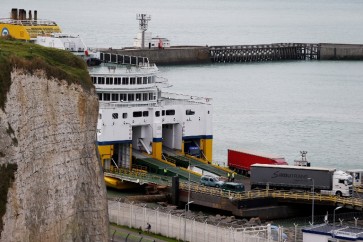Popular Reads
Top Results
Can't find what you're looking for?
View all search resultsPopular Reads
Top Results
Can't find what you're looking for?
View all search resultsLawang Sewu: Ahaunted, sad place
Framed view: The internal courtyard is attractively framed by galleries and cloisters
Change text size
Gift Premium Articles
to Anyone
Framed view: The internal courtyard is attractively framed by galleries and cloisters. JP/Simon Marcus Gower
Looming magnificently and yet sadly, over a major traffic island in central Semarang stands the building known as Lawang Sewu.
Lawang Sewu has many tales to tell but today it is quite tragically neglected and wasting away. This grand building stands empty and, in parts, is desperately dilapidated.
It was built by the Dutch in the mid-19th century as the headquarters for their Nederlandsch-Indische Spoorweg Maatschappij, or the Dutch Indies Rail Company. In its day it dominated the surrounding area with its high towers and sprawling footprint but in the war years of the 1940s it seems the Japanese made particularly nasty use of it.
Interrogations were apparently held within the confines of the building and many of the victims were even killed by the invaders inside its walls. It is from these more gruesome aspects of the building’s past that ghost tales arise.
There are tales told of headless ghouls wandering the corridors and of a young Dutch lady who killed herself in the building, for reasons unknown. But perhaps the design and current condition of the building allows for the embellishment of these tales.
The building is known as Lawang Sewu, which can be translated as the Building of a Thousand Doors. There are a very great many doors in the building but it is unlikely that there are actually a thousand. It is true though that there are long corridors with numerous doors and rooms along them. It is but a small stretch of the imagination to imagine ghosts and ghouls weaving their way between these rooms and through these doors.
Sadly it is a greater stretch of the imagination to conjure up images of what the building must have been like in its heyday. Today it is a dark and evidently sick. Its white walls are faded throughout; blackened by pollution and neglect. Rendered walls are cracked and any wall paper has long since fallen away to reveal the red bricks beneath. Mould and weeds grow over much of the building and mice and rats are the chief residents.
But even with all this neglect and terrible dilapidation there are parts of the building that survive and give hints at its former, undoubted glory. Take for example the main and central entry point into the building. Stepping into the building from here one is confronted by a monumental and powerful staircase that would not look out of place in an ancient castle or cathedral.
Light streams down onto this great stone staircase, colored by the glass through which it filters. Incredibly, given the extent of neglect and damage, these huge, high windows remain intact and what a wonder to the eye they are!
Arriving at the right time of day, it is possible to see these stain-glass windows in a wonderful riot of color. Light streams through, bringing them to life with their vibrant colors, which are perhaps accentuated by the grey stones of the staircase, and neglected walls that surround it.
The Dutch cities of Rotterdam, The Hague and Amsterdam are depicted in the glass. Coats of arms sit at the tops of the windows and beneath these are two large, full-length female figures whose flowing robes are detailed and rich in color.
On other parts of the windows are details that are indicative of the colonial and mercantile origins of the building. There is a representation of a steamship riding the waves presumably between Europe and the Indonesian archipelago. Central to all of the windows is a single wheel, seemingly emerging from clouds. This alludes to the building’s railway connection.
Grand view: Lawang Sewu stands magnificently overlooking a major traffic in Semarang city center. JP/Simon Marcus Gower
Little else, though, is left in the building to suggest its original purpose. Rooms that were perhaps once busy offices are now empty and look forlorn. In parts, temporary columns have been installed to keep roof from falling in. The neglect is wretched and one wonders how long a building can survive in such a state.
The neglect is made all the more sad, even shameful, considering the quality of the building’s design. Its open galleries and ground floor cloisters are solid and fortress-like but there are subtle details too within the building. The stain-glass windows are an excellent example of this but elsewhere there are fine architectural touches.
Turning a corner the visitor arrives at a dark hole that runs between floors. Nothing can really be seen in this black hole but shine a light down it and what is revealed is a beautifully detailed cast-iron spiral staircase that is probably more than 100 years old; today though it is disused and covered in a thick layer of sooty dust.
Many of Lawang Sewu’s legendary doors have been lost and those that remain nearly all seem to have been stripped of their locks and handles. The empty, high-ceilinged corridors of the building no longer echo with the voices and hubbub of offices workers; instead only the voices of curious visitors are heard and many of these visitors come because of the building’s reputation for ghosts.
But tales of ghosts and ghouls should not be what this great building is all about. Bandung has its Gedung Sate, a great building that has become a symbol of that city. Semarang should have Lawang Sewu as a living and actively used building and symbol of its status.
Some say that the ghost-stories associated with the building deter people from renovating and bringing it back to use and life. How silly this does seem?!











